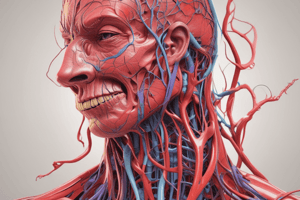Podcast
Questions and Answers
Which layer of the blood vessels consists of smooth muscle cells that supply mechanical strength and contractile force?
Which layer of the blood vessels consists of smooth muscle cells that supply mechanical strength and contractile force?
- Tunica Adventitia
- Tunica Media (correct)
- Tunica Intima
- Endothelial cells
Which type of blood vessels are capable of great degrees of distension and elastic recoil due to the numerous elastic fibers present in the tunica media?
Which type of blood vessels are capable of great degrees of distension and elastic recoil due to the numerous elastic fibers present in the tunica media?
- Elastic Arteries (correct)
- Veins
- Muscular Arteries
- Capillaries
Which class of arteries serve as stiff conduits that are not very prone to collapse, and have a relatively thick tunica media containing a high proportion of smooth muscle cells?
Which class of arteries serve as stiff conduits that are not very prone to collapse, and have a relatively thick tunica media containing a high proportion of smooth muscle cells?
- Capillaries
- Muscular Arteries (correct)
- Elastic Arteries
- Veins
In which blood vessels does the main resistance to blood flow take place?
In which blood vessels does the main resistance to blood flow take place?
What is the innermost layer of all blood vessels called?
What is the innermost layer of all blood vessels called?
What is the outermost layer of the blood vessels called?
What is the outermost layer of the blood vessels called?
Which of the following is NOT a topic covered in Chapter 1 of the textbook?
Which of the following is NOT a topic covered in Chapter 1 of the textbook?
What is Laplace's Law used for in cardiovascular physiology?
What is Laplace's Law used for in cardiovascular physiology?
Which of the following is NOT a component of the cardiac action potential?
Which of the following is NOT a component of the cardiac action potential?
What is the purpose of the Fick Principle in estimating cardiac output?
What is the purpose of the Fick Principle in estimating cardiac output?
Which of the following is NOT a method of regulating cardiac output?
Which of the following is NOT a method of regulating cardiac output?
What is the purpose of the electrocardiogram (ECG)?
What is the purpose of the electrocardiogram (ECG)?
Which process is responsible for transporting molecules throughout the body in a stream of pumped fluid?
Which process is responsible for transporting molecules throughout the body in a stream of pumped fluid?
What is the role of the heart in the circulatory system?
What is the role of the heart in the circulatory system?
What is the term for the period in which the heart is contracting?
What is the term for the period in which the heart is contracting?
What is the formula for calculating cardiac output?
What is the formula for calculating cardiac output?
What is the term for the constriction of blood vessels due to contraction of smooth muscle cells?
What is the term for the constriction of blood vessels due to contraction of smooth muscle cells?
What are the two classes of mechanisms that can alter vessel tone?
What are the two classes of mechanisms that can alter vessel tone?
Which of the following is the primary function of the cardiovascular system?
Which of the following is the primary function of the cardiovascular system?
What is the diffusion coefficient (D) of most small solutes in dilute aqueous solutions?
What is the diffusion coefficient (D) of most small solutes in dilute aqueous solutions?
If the outer layers of the heart were dependent on receiving nutrients solely by diffusion, how long would it take for a nutrient to diffuse from the ventricular lumen to the outer layers of the epicardium?
If the outer layers of the heart were dependent on receiving nutrients solely by diffusion, how long would it take for a nutrient to diffuse from the ventricular lumen to the outer layers of the epicardium?
What is the primary means of transport of substances between cells and the blood stream?
What is the primary means of transport of substances between cells and the blood stream?
What is the equation that shows the time it takes for a molecule to move a distance x in one direction in free solution?
What is the equation that shows the time it takes for a molecule to move a distance x in one direction in free solution?
Which of the following is NOT a role of the cardiovascular system?
Which of the following is NOT a role of the cardiovascular system?
Which of the following statements about blood flow through constricted blood vessels is true?
Which of the following statements about blood flow through constricted blood vessels is true?
Which of the following is true about mean arterial pressure?
Which of the following is true about mean arterial pressure?
Which of the following is true about the circulation of blood in the pulmonary system?
Which of the following is true about the circulation of blood in the pulmonary system?
Which of the following is true about the distribution of cardiac output?
Which of the following is true about the distribution of cardiac output?
Which of the following is true about the relationship between blood flow and metabolic needs of tissues and organs?
Which of the following is true about the relationship between blood flow and metabolic needs of tissues and organs?
Which of the following is true about the structure and dimensions of blood vessels?
Which of the following is true about the structure and dimensions of blood vessels?
Flashcards are hidden until you start studying




